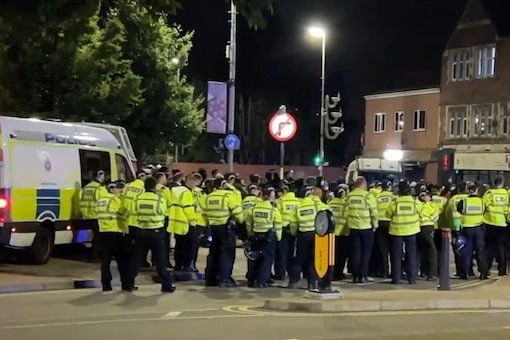

Leicester Police reported 'significant aggression' as dozens of officers were injured during the violence (Photo: IANS)
An on-ground report into the unprecedented communal violence in Leicester, the UK, during August-September 2022 blames the rise of “ethnic enclaves (organised by religion)” that led to “territorial tensions and localised majoritarianism”.
The investigation – Fact-finding Report on Leicester Violence 2022 – The Rise of Territorial Majoritarianism and Hinduphobia, was conducted by the Centre for Democracy, Pluralism, and Human Rights (CDPHR) and authored by Rashmi Samant and Chris Blackburn.
In August-September 2022, Leicester city witnessed protest marches, vandalism of Hindu homes and a temple as mobs of youth from other cities traveled to Leicester to foment violence and tensions. Over four dozen policemen were attacked and the social media was rife with messages calling for violence and revenge. The Leicester police, which initially took the violence lightly, had to call reinforcements from London as violence spiralled.
The report also looks into implications of the Leicester communal violence on the democratic values and “human rights of micro-minority communities” in a liberal and multi-faith and multi-cultural Britain.
It analyses the role of social media platforms and the mainstream media in fomenting violence and creating disharmony.
The report says: “By spreading misinformation, the attackers attempted to undermine fundamental principles of democracy and pluralism, including freedom of expression”, adding, “The organised dissemination of misinformation regarding the Hindu community and the sustained nature of the subsequent organised attacks which were extremely targeted in nature make it clear that the unrest was not spontaneous by any measure”.
The CDPHR report says: “Symptoms of territorial ethnic cleansing were found through the analysis of the different slogans and speeches made by the majority community {Muslim} of East Leicester and the temporary displacement of Hindu community as a result of the unrest”. It adds that the attacks were targeted against individuals based on their religious beliefs and affiliations, particularly the Hindus.
The report also looks at the role of contemporary politics in the Indian sub-continent where the Hindu minority and its religious symbols have been made consistent targets of attacks in Pakistan and Bangladesh. Moreover, in Kashmir the Hindus have been ethnically cleansed by the Muslim majority with moral and violent support from Pakistan – and a similar attempt was made in Leicester last year.
In this regard, the report says that there has been an export of the idea of “territorial majoritarianism” from Bangladesh, Pakistan and Kashmir into Leicester and attempts at ethnic cleansing which resulted in the temporary displacement of Hindu families from their homes.
The report says: “There was an attempt to defame and vilify the Hindu community as Hindutva nationalist and extremists with malicious propaganda of false kidnapping of a minor Muslim girl, false stabbing of Muslim traffic warden, false account of a mosque attack and false accusation of desecration of the Quran”.
Through its ground-based investigation, CDPHR has also highlighted how the British mainstream media and the local police were misled by Islamists in Leicester. It points how “institutional Hinduphobia and bias was deduced through the analysis of the reporting of the Leicester unrest” by the BBC and The Guardian as compared to police reports, witness accounts and investigations by think tanks.
The reports says the unrest started with social media misinformation and amplification, though many of these posts have subsequently been deleted. It takes notes of a number of British Muslims who issued a series of fake news against the Hindus leading to attacks amidst a growing trend of Hinduphobia.
The detailed report also presents the break-up and growth of religions where it finds that the Muslim population has grown from 30,885 to 86,443 between 2001 to 2021 while there is a considerable decline in the Christian population from 125,187 in 2001 to just 91,161 in 2021. The Hindu population has marginally grown from 41,248 to 65,821 during the same period. It says that most of the Muslim migrants to Leicester have come from Pakistan, Bangladesh and Somalia.
The report has provided suggestions and recommendations for lawmakers, enforcement agencies, the British civil society, faith-based organisations as well as community leaders to avoid similar incidents in the future.
Among the various measures, CDPHR has urged the government and the media to address the rise of extremism and hate speech. It also suggests that the public be educated on democratic values such as tolerance, respect, and dialogue.
It has also suggested that the common citizen be educated on how to differentiate between reliable and unreliable sources of information on social media. Regarding the mainstream media, the recommendations include setting up an independent ombudsman and a public complaints system.
The CDPHR has recommended the involvement of civil society organisations in promoting pluralism and tolerance among the diverse faiths of Leicester – a city known as a melting pot for different faiths and diverse cultures.
Also read: UK Home Secretary Suella Braverman visits troubled Leicester—Islamist lies nailed
NATO's recent decision to ramp up military spending will not significantly impact Russia's security, Foreign…
India has imposed anti-dumping duties on imports of Plastic Processing Machines from China and Taiwan,…
The Human Rights Desk of the Department of Information and International Relations for the Central…
India's trade delegation is currently in the United States for high-stakes negotiations aimed at finalising…
Defence Minister Rajnath Singh held a meeting with his Russian counterpart Andrey Belousov on the…
Hailing the all-party delegation which travelled to 33 different countries as part of India's global…